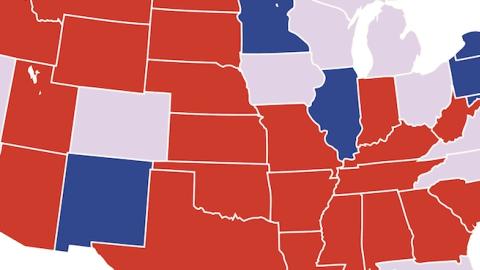Republicans and their allies seem determined to try to blame their electoral woes on anything other than their own poor messaging, their failure to listen to Main Street voters (a fact that Donald Trump capitalized on) and their woefully deficient nomination process (which has now produced Trump as the party’s nominee). At the Washington Post, Chris Cillizza writes that America has "an electoral map in which the Democratic nominee begins at a significant advantage over the Republican one." This is a somewhat convenient line of argument for Republicans to make—as it encourages them to throw up their hands rather than roll up their sleeves—but it's false.
Cillizza (in a piece entitled, "Republicans Have a Massive Electoral Map Problem That Has Nothing to Do with Donald Trump") writes,
"If [Hillary] Clinton wins the 19 states (and D.C.) that every Democratic nominee has won from 1992 to 2012, she has 242 electoral votes. Add Florida's 29 and you get 271. Game over."
He adds,
"There are 13 states that have gone for the GOP presidential nominee in each of the last six elections. But they only total 102 electorate votes. That means the eventual nominee has to find, at least, 168 more electoral votes to get to 270. Which is a hell of a lot harder than finding 28 electoral votes."
But why base one's analysis on the past six elections, going back to Bill Clinton's first election in 1992, rather than on the past seven (or eight)?
If one includes the past seven elections (four of which have been won by Democrats), going back to George H. W. Bush's win in an open race in 1988, the tallies change dramatically. Over the past seven elections, there are 8 states (plus D.C.) that the Democratic nominee has won each time: Hawaii, Massachusetts, Minnesota, New York, Oregon, Rhode Island, Washington, and Wisconsin. Those 8 states total 90 electoral votes. Meanwhile, there are 13 states that Republicans have won every time: Alabama, Alaska, Idaho, Kansas, Mississippi, Nebraska, North Dakota, Oklahoma, South Carolina, South Dakota, Texas, Utah, and Wyoming. Those 13 states total 102 electoral votes.
So, based on the way things have played out in each of the past seven elections, Republicans start with a 102-90 electoral-vote advantage.
What's more, Republicans have come a lot closer to winning in these Democratic states than vice versa. Ten times over the past seven elections, Republicans have come within 5 points in one of these Democratic states, while Democrats have come within 5 points in one of these Republican states just four times—and never since the 1990s. (Barack Obama didn't come within 10 points in any of these GOP states in 2012.) Three times over that span, Republicans have come within 0.5 points in one of these Democratic states (George W. Bush in Wisconsin in 2000 and 2004, and in Oregon in 2000), while the Democrats haven't come that close in any of these Republican states.
(If one goes back eight elections, to Ronald Reagan, Republicans would start with an implied electoral-vote advantage of 102-10. But that's too generous for the GOP, for the obvious reason that Reagan was one of a kind.)
I wrote the following nearly five years ago, and the only thing that has since changed is that Virginia has become a true toss-up state (partly because it has an ever-increasing number of federal workers in the D.C. suburbs):
"[I]t looks like 13 states will be somewhat or very competitive [in the presidential race]. Of the somewhat competitive states, three are Democratic-leaning—Michigan, Minnesota, and New Mexico—while the fourth leans Republican: North Carolina. Let's assume they stay in those respective columns. When added to the 37 predictable states, the electoral tally would be Democrats 217, Republicans 206.
"And the 9 very competitive states? Three of these lean Republican: Florida (29 electoral votes), Ohio (18), and Virginia (13). Three lean Democratic: Pennsylvania (20), Wisconsin (10), and Nevada (6). And three are essentially toss-ups: Colorado (9), Iowa (6), and New Hampshire (4). If each party holds all of the states that lean its way, the electoral tally will be Republicans 266, Democrats 253, with Colorado, Iowa, and New Hampshire hanging in the balance. To prevail, the Republican nominee will have to win one of these three remaining states."
With Virginia now in the toss-up category, if each party wins every state that leans its way, the tally would be 253-253, with Virginia, Colorado, Iowa, New Hampshire remaining on the board.
So the map isn't the Republicans' problem. Their problem is their messaging, their reluctance to listen to Main Street voters, and their broken nomination process—which clearly calls out for reform, along the lines of what Jay Cost and I have proposed.
But the one thing Republicans have going for them is that they'll be running against a Democrat, and a weak one at that. So they might still win—even with Trump as the nominee.















